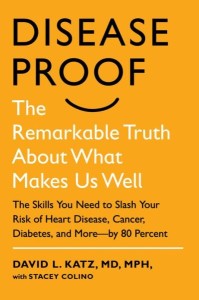-
Move Your Body, Lose the Health Risks
Wednesday, July 2nd, 2025by David Katz, M.D., Director, Yale Prevention Research Center
A sedentary lifestyle is a major risk factor for heart disease, stroke, diabetes, osteoporosis, many forms of cancer, and premature death.
 Conversely, regular physical activity has been shown to reduce the risks of developing cardiovascular disease, type 2 diabetes, hypertension, breast and colon cancer, and many other life-threatening diseases.
Conversely, regular physical activity has been shown to reduce the risks of developing cardiovascular disease, type 2 diabetes, hypertension, breast and colon cancer, and many other life-threatening diseases. Compared to being sedentary, routine physical activity can cut the risk of developing any major chronic disease in half. That’s right – in half!
Physical inactivity has long been recognized as one of the top three causes of premature death in the United States, but a recent review of the global evidence, published in The Lancet, indicates that physical inactivity is now responsible for nearly 10 percent of the world’s annual mortality.
Moreover, in a study involving 222,497 people ages forty-five and older, researchers at the University of Sydney in Australia found that the risk of dying from any cause was 15 percent higher among those who sit for eight to ten hours a day and 40 percent higher among those who sit for eleven hours a day or longer.
The pattern was consistent among men and women, overweight people and thin folks, and people who exercise as well as those who don’t.
In other words, spending many hours a day sitting is simply harmful to your health, even if you are physically active when you’re not resting on your tush.
Human Beings Were Built for Movement
From an evolutionary perspective, human beings were built for movement, not spending long hours sitting on our derrieres.
In this age of automated everything, we have essentially engineered movement right out of our lives. We no longer hunt or gather; we order takeout food, often for delivery.
We do our banking online and use direct deposit. We no longer have to walk to a colleague’s office to confer on a matter; phone or e-mail is the go-to mode of communication.
We no longer have to go shopping for groceries, clothes, furniture, or other items; we can order what we want or need on our computers and have it sent directly to our homes.
Exercise has been squeezed out of the average day for both adults and kids.
Despite the epidemics of obesity and type 2 diabetes in children, more and more schools are cutting back on physical education programs, rather than expanding them.
This is happening even though there’s solid evidence that good physical activity programs during the school day preserve or enhance academic performance, rather than interfering with it.
According to a study by researchers at the University of Tennessee, Knoxville, middle-school students who are more physically fit (especially on measures of cardiorespiratory endurance, muscular strength, and stamina) achieve better grades and perform better than their classmates on standardized tests.
For years, approximately 40 percent of adults in the United States reported that they never exercise.
More recent studies are painting an even worse picture:
Using accelerometers to measure actual movement, instead of relying on study participants’ self-reports, the latest research indicates that only 3.5 percent of adults in the United States between the ages of eighteen and fifty-nine achieve the minimum amount of physical activity that’s recommended by the government: 150 minutes of moderate-intensity activity per week. Only 3.5 percent!
The Rise of Sedentarism
This lifestyle has given rise to a phenomenon now being referred to in research circles as “sedentarism,” which is variously described as expending less than 10 percent of your daily energy (or calories) performing moderate to vigorous physical activities, spending an inordinate amount of time sitting down during your leisure time, or a combination of the two.
In popular culture, by contrast, sedentarism usually refers to extended engagement in behaviors that involve little movement and low calorie expenditure (such as watching TV).
Meanwhile, “sedentary physiology” – the opposite of “exercise physiology” – has become an increasingly rich area of scientific inquiry, because this behavior has such serious, deleterious health consequences.
Any way you look at it, we are gaining weight and increasing our risks of chronic diseases by the seat of our pants, not the soles of our shoes.
It shouldn’t be this way. Fortunately, the solution is fairly simple: Move more! Really!
(published October 24, 2013)
 Excerpted from DISEASE-PROOF by David L. Katz, MD, MPH with Stacey Colino. Reprinted by arrangement with Hudson Street Press, a member of Penguin Group (USA) LLC, A Penguin Random House Company. Copyright © David L. Katz, MD, MPH, and Stacey Colino, 2013.
Excerpted from DISEASE-PROOF by David L. Katz, MD, MPH with Stacey Colino. Reprinted by arrangement with Hudson Street Press, a member of Penguin Group (USA) LLC, A Penguin Random House Company. Copyright © David L. Katz, MD, MPH, and Stacey Colino, 2013.
Dr. Katz is the founding director of Yale University’s Prevention Research Center. He is a board certified specialist in both Internal Medicine and Preventive Medicine/Public Health. Katz is known internationally for expertise in nutrition, weight management, and chronic disease prevention, as well as integrative care and patient-centered care models. His website is DavidKatzMD.com.


